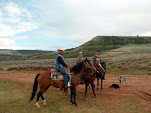Downtown Licking, MO
Living south of Beulah, Missouri, Thomas Logan Johnson, was about to prove up in 1862 on over 160 acres of land he had filed homestead patents on in addition to lands he proved up on in 1856. In May, he married Julia Ann Dension, ten years younger than he was. Oral family history says Julia was a small, dark-haired woman.
Logan (as he always went by) was 29 years old. There was a spacious well built house on his farm in Spring Creek Township, Phelps County, Missouri and he was a slave owner although I've not been able to find out how many. Known for raising fine horses, the new Mrs. Johnson must have looked forward to a bright future.
It was not to be. In August of 1862, both the Union and Confederate armies were conscripting soldiers. Thomas Logan Johnson went with his neighbors to Oregon County, Missouri and wound up in Company C of the Missouri 8th Infantry CSA as a 2nd Lieutenant. He would not see his wife, nor the new baby, Annie, who arrived in the Spring of 1863, for three years. He also would not see any paycheck the entire time he served.
Meanwhile, Julia endured I don't know what from both Confederate and Union raiders. The Union Army had moved into the county seat, Rolla, with 10,000 soldiers after the defeat at Wilson's Creek. In it's infinite wisdom, the government in Washington D.C. paid it's army in useless script with the result of turning 10,000 hungry soldiers into the county raiding for their daily bread. It must have been horrific.
How long Julia managed to stay on the farm, I haven't discovered. But in August of 1864, the Union Provost Marshall in Rolla began seizing all the Confederate farms for 'bushwhacking' activities. By the time the war ended in the Trans-Mississippi Area in May of 1865:
a) Thomas Logan Johnson had fought in 3 battles; Prairie Grove in Northern Arkansas shortly after enlisting in December of 1862, Battle of Pleasant Hill south of Shreveport, Louisiana in early April of 1864, and at Jenkins Ferry in Central Arkansas in late April of 1864 where he was on the Confederate Roll of Honor. He was also now 1st Lieutenant of Company C.
b) Where was Julia by the end of the war? Somewhere near Beulah, Missouri but she had no slaves, no farm, no horses and no home. At some point, the house had been burned. Everything had been swept away by the war. All she had was three year old Annie. And where was her husband?
One of the released soldiers from the unit told her. Logan was in a military camp, Camp Magruder, near Minden, Louisana, too ill to make it home. Twenty odd miles from Shreveport, he had been too ill to even go to Shreveport to sign the oath of allegiance - a requirement for release. She had to go get him -- almost 400 miles through wooded countryside with a military government and hundreds of bushwhackers. She was going to have to depend upon the generosity of strangers to eat and for shelter.
And so she decided she WAS going to get him. She didn't know if he would be alive when she got there. And she was taking Annie with her.
I questioned why she would take a 3 year old on such an ardous journey. I decided it was because she didn't know what awaited her, perhaps a dead husband, perhaps a man who couldn't make it home, perhaps she couldn't make it back. Leaving her child to an unknown fate was not a choice she wanted to make perhaps.
Starting from Beulah according to family oral history, she made her way to Licking, Missouri, where she managed to get a horse, albeit one that was old and barely servicable, from the Union Army in Licking. Putting Annie on the horse (and maybe herself also) she started for Louisana.
A few traces of the Civil War or post war era remained in the architecture of Licking. However I found out nothing about the post war occupation while there as the local museum was closed. Perhaps the next trip.
Cornice of one of the buildings in Licking.
The railroad station to the left. This had to be a post civil war station or perhaps even early 20th century as the railroad ended in Rolla during the war.
Next -- The trip





Amazing story - she was one gutsy lady!
ReplyDelete